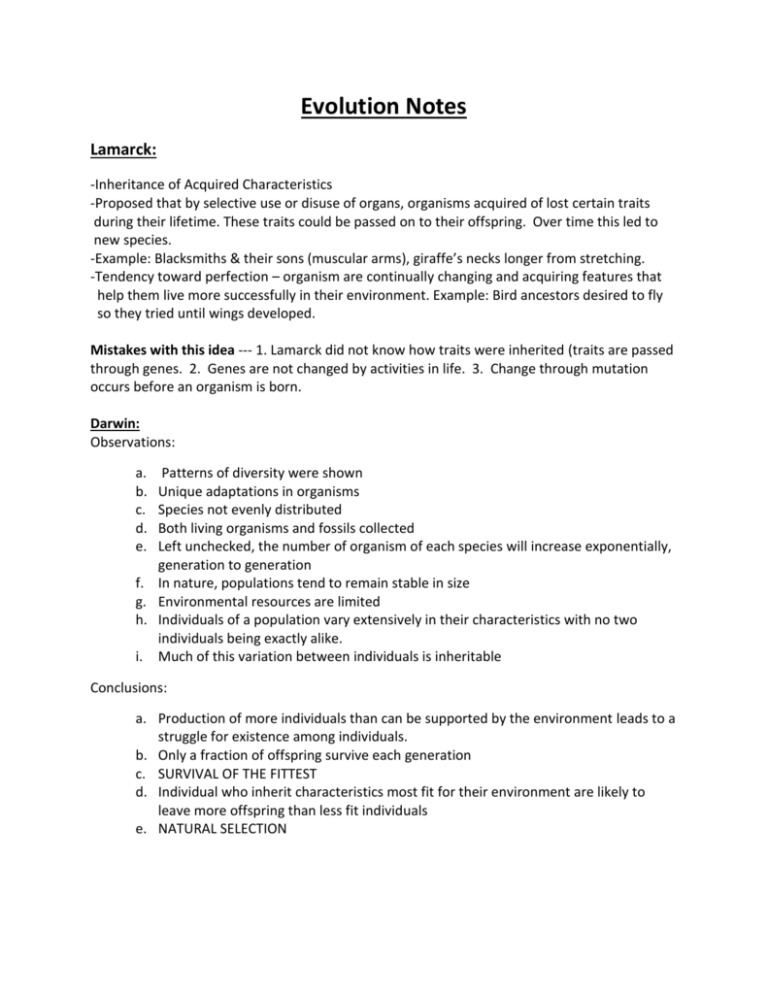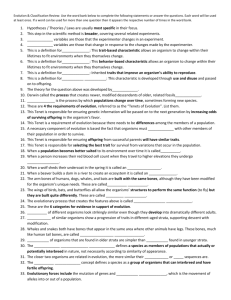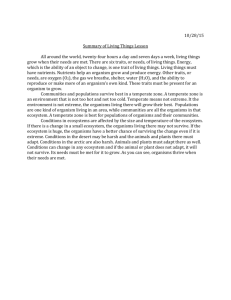Evolution Notes Lamarck
advertisement

Evolution Notes Lamarck: -Inheritance of Acquired Characteristics -Proposed that by selective use or disuse of organs, organisms acquired of lost certain traits during their lifetime. These traits could be passed on to their offspring. Over time this led to new species. -Example: Blacksmiths & their sons (muscular arms), giraffe’s necks longer from stretching. -Tendency toward perfection – organism are continually changing and acquiring features that help them live more successfully in their environment. Example: Bird ancestors desired to fly so they tried until wings developed. Mistakes with this idea --- 1. Lamarck did not know how traits were inherited (traits are passed through genes. 2. Genes are not changed by activities in life. 3. Change through mutation occurs before an organism is born. Darwin: Observations: a. b. c. d. e. Patterns of diversity were shown Unique adaptations in organisms Species not evenly distributed Both living organisms and fossils collected Left unchecked, the number of organism of each species will increase exponentially, generation to generation f. In nature, populations tend to remain stable in size g. Environmental resources are limited h. Individuals of a population vary extensively in their characteristics with no two individuals being exactly alike. i. Much of this variation between individuals is inheritable Conclusions: a. Production of more individuals than can be supported by the environment leads to a struggle for existence among individuals. b. Only a fraction of offspring survive each generation c. SURVIVAL OF THE FITTEST d. Individual who inherit characteristics most fit for their environment are likely to leave more offspring than less fit individuals e. NATURAL SELECTION THEORY OF EVOLUTION: The unequal ability of individuals to survive and reproduce leads to a gradual change in a population, with favorable characteristics accumulating over generations. EVOLUTION – the slow, gradual change in a population of organisms over time COMMON DESCENT WITH MODIFICATION -Darwin proposed that organisms descended from common ancestors -Idea that organisms change with time, diverging from a common form -Caused evolution of new species NATURAL SELECTION -Driving force of evolution -During the struggle for resources, the most fit will survive and reproduce -Idea that a least some of the differences between individuals, which impact their survival and fertility, are inheritable. ARTIFICIAL SELECTION -Selective breeding to enhance desired traits among stock or crops -Nature provided the variation among different organisms, and humans selected those variations that they found useful. Evolution by Natural Selection Concepts 1. The struggle for existence (compete for food, mates, space, water, etc.) 2. Survival of the fittest (most fit are able to survive and reproduce) 3. Descent with Modification (new species arise from common ancestor replacing less fit species. FITNESS – Ability of an individual to survive and reproduce ADAPTATION – Inherited characteristic that increases and organisms chance for survival Physical (speed, camouflage, claws, quills) and Behavioral (herd, packs) Theory of Evolution Today – Supporting Evidence 1. Fossil Record – Fossils in different layers of rock showed evidence of gradual change over time. 2. Geographical Distribution of Living Species – different animals on different continents but similar adaptations to similar environments. 3. Homologous Structures of Living Organisms – structures that have different mature form but develop from the same embryonic tissues. Similar structure but not necessarily the same function. Analogous structures are similar function but not the same structure. Vestigial Organ – does not have a function in the organism. 4. Similarities in Early Development – Embryo – early stages of vertebrate development. Embryonic structures of different species show significant similarties 5. Biochemistry – similarities in DNA sequences and proteins REVIEW 1. Individual Organisms In Nature Differ From One Another. Some Of This Variation Is Inherited 2. Organisms In Nature Produce More Offspring Than Can Survive, And Many Of These Offspring Do Not Reproduce 3. Because More Organisms Are Produced Than Can Survive, Members Of Each Species Must Compete For Limited Resources 4. Because Each Organism Is Unique, Each Has Different Advantages & Disadvantages In The Struggle For Existence 5. Individuals Best Suited To Their Environment Survive & Reproduce Successfully – Passing Their Traits To Their Offspring. 6. Species Change Over Time. Over Long Periods, Natural Selection Causes Changes That May Eventually Lead To New Species 7. Species Alive Today Have Descended With Modifications From Species That Lived In The Past 8. All Organisms On Earth Are United Into A Single Tree Of Life By Common Descent WHAT DO WE KNOW TODAY The Gene Pool: -Members of a species can interbreed and produce fertile offspring -Species have a shared gene pool -Gene pool – all of the alleles of all individuals in a population -Different species do NOT exchange genes by interbreeding -Different species that do interbreed often produce sterile or less viable offspring Populations: -A group of the same species living in an area -No two individuals are exactly alike (variation) -more fit individuals survive and pass on their traits. Speciation: -Formation of new species -One species may split into 2 or more species -A species may evolve into a new species -require very long periods of time MODERN EVOLUTIONARY THOUGHT Population genetics – study of genetic variation within a population. Emphasis on quantitative characteristics (height, size) Today’s theory of evolution: A. Recognizes that genes are responsible for the inheritance of characteristics. B. Recognizes that populations, not individuals, evolve due to natural selection and genetic drift. C. Recognizes that speciation usually is due to the gradual accumulation of small genetic changes. MICROEVOLUTION – Change occur in gene pools due to mutation, natural selection, genetic drift, etc. Causes more variation in the population. Does not form a new species. Causes of Microevolution: Genetic Drift – the change in the gene pool of a small population due to chance. Natural selection – success in reproduction based on heritable traits results in selected alleles being passed to relatively more offspring Gene flow – is genetic exchange due to the migration of fertile individuals or gametes between populations. Mutation – a change in an organism’s DNA. Can be transmitted in gametes to offspring. Non-random mating – mates are chosen on the basis of the best traits GENETIC DRIFT – • Bottleneck Effect - a drastic reduction in population (volcanoes, earthquakes, landslides) - Reduced genetic variation - Smaller population may not be able to adapt to new selection pressures • • Founder Effect - occurs when a new colony is started by a few members of the original population - Reduced genetic variation • May lead to speciation Cheetahs have little genetic variation in their gene pool. This can probably be attributed to a population bottleneck they experienced around 10,000 years ago, barely avoiding extinction at the end of the last ice age MODES OF NATURAL SELECTION • Directional Selection - Favors individuals at one end of the phenotypic range - Most common during times of environmental change or when moving to new habitats • Disruptive selection - Favors extreme over intermediate phenotypes - Occurs when environmental change favors an extreme phenotype • - Stabilizing Selection Favors intermediate over extreme phenotypes Reduces variation and maintains the current average Example: Human birth weight VARIATIONS IN POPULATION • • • • • • Variation in a species due to climate or another geographical condition Populations live in different locations Example: Finches of Galapagos Islands & South America Mutations In stable environments, mutations often result in little or no benefit to an organism, or are often harmful Mutations are more beneficial (rare) in changing environments (Example: HIV resistance to antiviral drugs) Genetic Recombination source of most genetic differences between individuals in a population Co-evolution -Often occurs between parasite & host and flowers & their pollinators










